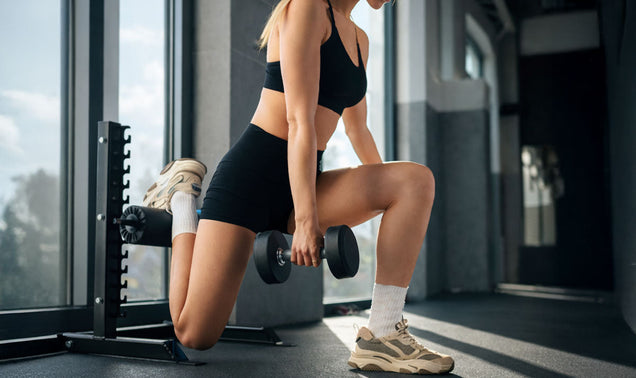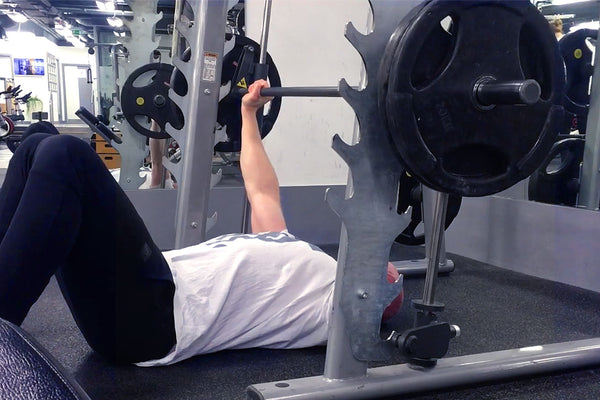The floor press is one of our favorite bench press variations to build muscle, gain strength, and help break through training plateaus.
Typically, the exercise is performed using a barbell, Swiss bar, or pair of dumbbells.
There are many similarities between the traditional flat bench press and the floor press (compound exercise, builds muscle and strength in the chest, shoulders, and triceps, etc.).
The main difference being that with the floor press you’re laying on the floor instead of a flat bench.
The floor press also offers several benefits to those who might not feel comfortable performing a traditional barbell bench press, have a history of shoulder pain, or don’t have access to a bench at home.
The reason that floor presses are good for those who typically experience shoulder pain when performing traditional bench presses is that the floor limits how far you can lower the bar, which thereby reduces the amount of shoulder extension and internal rotation that can occur.
This is particularly helpful for lifters with long arms.
An underrated benefit of pressing from the floor, is that it ensures that you use the same range of motion on every rep, as your elbows should contact the floor at the bottom of each rep.
Technically you can ensure the same range of motion with a traditional bench press (by touching the barbell to your chest every rep), but for lifters with long arms, touching the bar to the chest creates unwanted stress on the shoulder joint due to the amount of extension involved.
And for those who struggle with the lockout on their other pressing movements, the floor press is ideally suited to shore up this weakness as it targets the triceps, which are the primary drivers of the lockout on pressing exercises (bench press, dumbbell press, overhead press, military press, Arnold press, dips, etc.)
The floor press is also good for people with a history of low back pain as pressing from the floor helps reduce the amount lumbar extension you can do.
Yet another reason to consider adding the floor press to your workout plan is that it is a better pressing option for individuals who struggle to maintain stability during bench pressing due to a lack of stability.
The floor press provides rock-solid stability because your entire upper back is in contact with the ground. This increased stability means you can transfer greater force to the bar, creating more overload on your chest, shoulders, and triceps without having to struggle with as much balance as you would in a bench press.
This is especially important for beginners who struggle to understand how to control the barbell through space as they raise and lower it.
Having the entire upper back in contact with the floor also helps fortify scapular stability, which is critical to lifting as much weight as you are truly capable of, not to mention preserving shoulder health.
Now, don’t take this to mean that the bench press is a bad exercise.
Quite the opposite, actually.
The bench press is a phenomenal exercise to build muscle and strength. It’s just that not everyone is built to bench with a barbell.
But, that’s ok.
You can still achieve just as fantastic results using the floor press and other pressing exercises to build your chest, shoulders, and triceps.
Now, as we mentioned above, the floor press can be performed using a barbell, swiss (football) bar, dumbbells, or kettlebells.
It can also be performed in the Smith machine.
While each lifting implement has its own unique set of benefits to offer, let’s discuss why we like the Smith Machine Floor Press.
Why Use the Smith Machine Floor Press
One of the main reasons we like the Smith Machine floor press is that it’s a good pressing option for beginner lifters who may not have the requisite stability and/or coordination to perform chest presses with free weights (dumbbells, barbells, etc.).
Using the Smith machine reduces the amount of balancing you have to do, thereby allowing you to focus on using your chest and triceps to press the weight up.
More advanced lifters who feel comfortable using free weights can use the Smith Machine floor press as a secondary or tertiary exercise in their upper body workouts to create more overload on their pushing muscles without having to do as much balancing or stabilizing.
As you go through a workout, the supporting muscles become fatigued and can be the limiting factor in how much weight you can lift or how many reps you can perform.
Using machine exercises, such as the Smith Machine floor press, reduces the degree to which these “supporting” muscles have to work, enabling you to exhaust the target muscles (chest and triceps) more completely, which makes for a better workout.
Again, as we mentioned above, the Smith Machine floor press helps ensure you use the same range of motion each rep (which helps prevent cheating), and improves strength on the mid-range and lockout.
How to Use the Smith Machine Floor Press in Your Workouts
How to use the Smith Machine floor press depends on your goals and experience levels.
For beginners, intermediates, or advanced lifters, the floor press can serve as their primary horizontal pressing exercise.
However, more advanced lifters may prefer to begin their upper body workouts with the traditional barbell or dumbbell bench press.
This is why we typically use the floor press as the second or third exercise in more advanced workouts.
As we mentioned previously, the deeper you get into a workout, the more your stabilizing muscles become the limiting factor in your performance.
Using a machine exercise helps reduce the amount of work your stabilizers have to do, thereby allowing you to focus on the “primary movers” and really blast them.
Furthermore, machine exercises also offer a safer option for training to (and beyond) failure than free weight exercises do. And, they’re also less taxing on the nervous system which makes them easier to recover from than training to failure on free weight exercises.
If you’re looking to add the Smith Machine floor press to your training program, here’s how we like to program it:
- Beginner: 3 sets of 8-12 reps at the beginning of your upper body workout
- Intermediate: 3 sets of 10-15 reps as the second pressing exercise in your upper body workout
- Advanced: Perform a “finisher” set of 100 reps with your 15-RM using rest-pause






